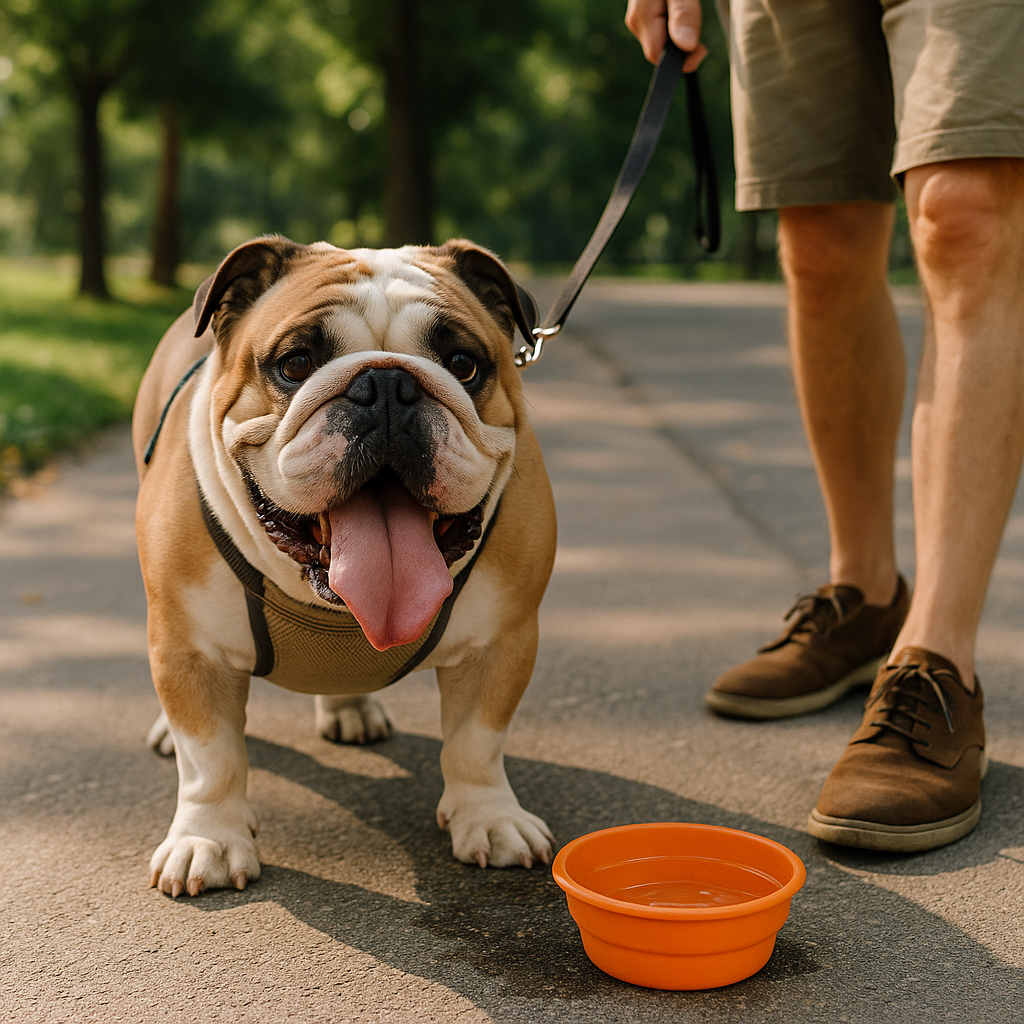The bulldog is a breed known for its calm temperament and compact body, but also for its sensitivity to heat and physical exertion. Although walks are essential for a bulldog’s physical and emotional health, it’s crucial to understand the specific care this breed requires to ensure safe, comfortable, and enjoyable outings.
In this article, you’ll learn how, when, and where to walk your bulldog, what warning signs to look for, and how to avoid overheating and excessive fatigue.
Yes, Bulldogs Need Walks
Despite their lazy reputation, bulldogs need regular physical activity to maintain a healthy weight, strengthen their muscles, stimulate their minds, and prevent boredom. The problem isn’t the exercise itself, but the intensity and the conditions under which it’s done.
Short, regular, and well-planned walks help keep bulldogs healthier, happier, and more balanced.
Heat and Bulldogs: A Dangerous Combination
Bulldogs are brachycephalic dogs — they have a short snout and compact airways. This makes it difficult for them to release heat through breathing, making them extremely sensitive to high temperatures.
On hot days, the risk of hyperthermia (a dangerous rise in body temperature) is very high. Walks must be done with great caution and only during the coolest times of the day.
Ideal times for walks:
- Between 6:00 and 8:00 a.m.
- After 6:00 p.m. (in summer)
- On cloudy days with a light breeze
Completely avoid walks between 10:00 a.m. and 5:00 p.m. on sunny days.
Duration and Pace of the Walk
The ideal walk for a bulldog is 15 to 20 minutes, twice a day. Long walks, especially on hot surfaces or without breaks, should be avoided.
Let your bulldog walk at their own pace. They may stop to sniff, observe, or rest. Never pull on the leash or force them to walk faster. The walk should be a pleasant experience, not an exhausting effort.
Essential Items for a Safe Walk
Before heading out with your bulldog, make sure you’re well prepared:
- Use a harness to avoid pressure on the neck and support better breathing
- Bring a bottle of fresh water and offer it during the walk
- Always carry poop bags
- Use a short but comfortable leash
- If possible, carry a damp towel to cool off their paws or back if needed
- Avoid using muzzles that restrict breathing or airflow, as they can worsen overheating
Hot Pavement Burns Paws
Asphalt, concrete, and even tile floors can reach dangerously high temperatures on hot days, causing burns on your bulldog’s paw pads.
Before leaving the house, do the back-of-the-hand test: if you can’t hold your hand on the ground for 5 seconds, it’s too hot for your dog.
If the walk is unavoidable, stick to grassy areas, shaded paths, and consider protective booties if needed.
How to Spot Signs of Fatigue or Overheating
Always pay attention to your bulldog’s behavior during and after a walk. Warning signs include:
- Excessive and noisy panting
- Very red or purple tongue
- Heavy drooling
- Disorientation or wobbly walking
- Vomiting or diarrhea
- Difficulty breathing even while resting
- Attempts to lie down during the walk
If you notice any of these signs, stop the walk immediately, move your dog to a shaded area, offer water, and if there’s no improvement, go to the vet right away.
Mental Stimulation Also Counts as Exercise
Not all walks have to be physical. Bulldogs can benefit greatly from activities that challenge their minds, such as:
- Shorter walks with more sniffing and exploring time
- Indoor treasure hunts
- Hiding treats for them to find
- Teaching simple commands
Mental stimulation can be just as tiring as a walk and is a great alternative during hot or rainy days.
Alternatives for Extremely Hot Days
If it’s too hot to go outside, consider offering these indoor alternatives:
- Play sessions at home with a ball or rope
- A lick mat with natural spread
- A cooling mat for them to lie on
- Quality time with brushing and cuddles
Remember: keeping a routine is important, but it should be adapted to the weather conditions.
Calm Environment Without Excessive Stimulation
Being a sensitive breed with a tendency toward anxiety, bulldogs do best in peaceful settings. Avoid areas with heavy traffic, bikes, loud noises, or overly excited dogs that may stress them out.
If you want to socialize them with other dogs, choose quiet parks, less busy times, and always respect your dog’s signals. If they seem uncomfortable or don’t want to play, don’t force it.
Conclusion: The Ideal Walk Respects the Bulldog
Walking a bulldog is much more than just “burning off energy.” It’s a time for stimulation, bonding, and well-being. When done with attention to the weather, ground, timing, pace, and hydration, it becomes a powerful tool for your companion’s physical and emotional health.
The key is to respect the breed’s natural limitations, observe their signals, and make walking a safe, gentle, and enjoyable habit.
